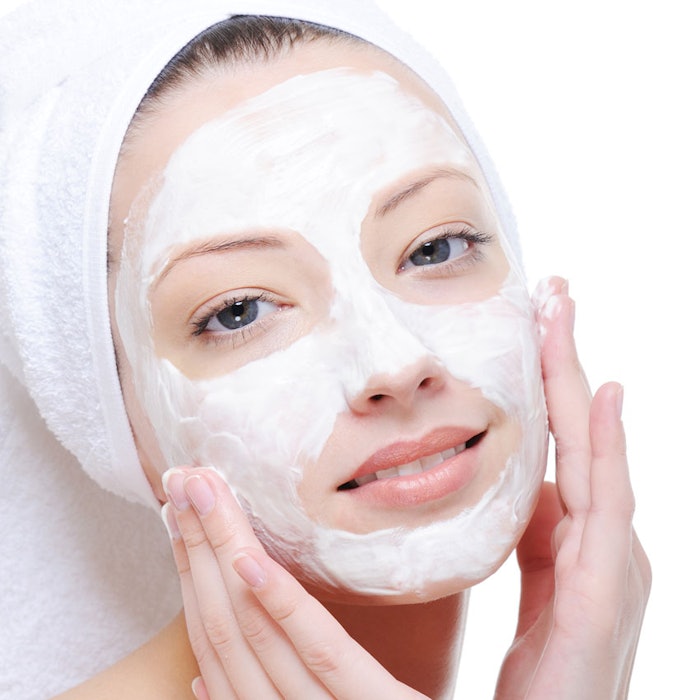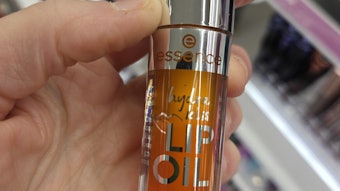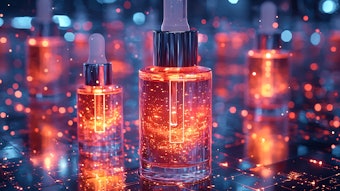
Even though facial masks have been around for decades, they have recently undergone a makeover with innovative ingredients, immediately perceived efficacy and creative functionalities that differentiate them from their predecessors. Traditional facial masks are temporarily applied to the face in a thick layer without massage. This film is known to dry quickly, and the residual film is peeled or rinsed off. Some are massaged until they aggregate into easy-to-eliminate rolls.
The application site and amount applied largely determine the rheological properties of facial masks. They are formulated to resemble viscous gels, pastes or thick emulsions. In general, they are shear-thinning products that are easily and homogeneously distributed on the face with the fingers. Once applied, the mask layer should remain in place and not drip. This is necessary to keep the product out of the eyes and mouth.
The main cosmetic objectives of facial masks are to provide: fast, deep moisturization; skin replenishment and restitution; sebum absorption and elimination; and skin rejuvenation. In addition, an immediate radiant complexion is expected by consumers after removing the mask. In other cases, and more frequently in esthetic practices, facial masks are applied over a face cream to help the penetration of actives by promoting intense skin hydration. In this case, they remain longer on the skin and are gently removed by wet wipes.
Some subcategories of facial masks exist, including those that involve evaporation and those are formulated into a substrate like a cloth, patch, pad or polymeric film to maintain their application. In evaporation masks, the water or hydro-alcoholic blend solvent is evaporated to leave a dry residue of solids and film-forming agents for a skin tightening effect. In other cases, the water phase is not easily evaporated due to its high, complex hydrotropes, and the applied layer maintains its initial structure during its intended performance time.
Formulation
From a physicochemical point of view, facial masks can be divided into three main types: emulsions, gels and suspensions. Each of these can be used to create a wide array of formulations, but facial masks generally exhibit simple combinations of ingredients presented in simple formulas with a few key ingredients. Moreover, formulations maintain a fairly low unit price to compensate for the high amounts used for each application. This price strategy is one of the reasons facial masks have seen recent growth. In addition, they present multifaceted formulation possibilities and save the consumer time by allowing for application during sleep, TV viewing, driving, etc.
Formulation methods for masks do not have peculiar characteristics, in comparison with standard cosmetic recipes, but some examples are given here. Exceptions are facial masks containing high amounts of solids that are either swelling or non-swelling. In these cases, ionic or nonionic surfactants are required to stabilize suspensions of micronized solids, in synergistic association with thickening polymeric ingredients or “concentrators.”1 It seems that interactions between polymeric macro chains, micelles formed by surfactants and solid particles make the systems more stable.
For the high viscosity of a facial mask, powders such as talc, kaolin, silica gels and clays must be incorporated into the formulation while avoiding the excessive incorporation of air; this delicate balance also is encountered in the production of toothpastes. In some cases, high powder load can create shear-thickening (dilatant) products, which require a slow blade motion and powerful engines. Moreover, powders tend to hydrate progressively during storage on the shelf, and the resulting behavior may transform smooth gels into hard “rocks.” Similarly, a slow hydration process takes place with hydrophilic polymers, and strategies must be developed to counteract this drawback. The examples given next demonstrate practically all these described aspects.
Peel-off Masks
Peel-off masks are applied as an even layer to the face and removed in continuous, peelable film after the given amount of time. In Formula 1, this suspension formulation is a blend of mostly solid powder ingredients. The dry blended powders are mixed 10:24 with water just before application onto the skin.2 The association between vegetal thickeners and absorbing porous silica is evident in this formula. Magnesium oxide and calcium sulfate form a compact mask after drying, maintaining facial contours.
A successful prototype for thousands of peel-off masks is the gel formulation shown in Formula 2, which is a jelly-type facial mask patented by Lion more than 20 years ago.3 Polyvinyl alcohol is the “king” of peelable face masks. It is slowly water-soluble and safe even for irritated skin; it is even used in surgical operations. Its aqueous solutions are stable and as transparent as water. Moreover, the process of transformation from aqueous gel to dry, transparent film can be tailored in terms of evaporation speed by the amount of volatile (alcohol) and non-volatile, e.g., propylene glycol, isopentyl diol, glycerin, etc., hydrophilic solvents. The only drawback is the length of time necessary to dissolve the polyvinyl alcohol granules in water, as they require adequate and slow mixing. After complete dissolution, other ingredients can be incorporated. Typically, the amount of polymer used is between 5% and 15%, and soothing, refreshing or nourishing actives may be added at the end. An ethoxylated surfactant is added in this case to dissolve the fragrance in the aqueous system. This formula could be kept as a model, to which one could add an assortment of fillers, colors and pearls to make it more attractive. An important development element is that care should be taken to check the influence of each addition to the evaporation time and mechanical resistance of the peelable film.
Another perhaps more complex example of this successful gel-type face mask was patented by Shiseido in 1995 (see Formula 3).4 In this mask, the hydrophilic solvents are carefully blended to obtain progressive evaporation but also an immediate moisturizing effect. Long term skin hydration is provided by sodium hyaluronate. Adequate thickening and elasticity characteristics are obtained with the use of xanthan gum. The formula is claimed to have excellent storage behavior due to the citrate-buffered pH. Tocopherol is added to protect fragrance from oxidation. Polyoxyethylenated compounds in association with solvents also ensure good potential for dissolution and the absorption of all sebaceous materials from the skin surface into the polyvinyl alcohol layer.
Similarly, Formula 4 enhances the viscosity value of the polyvinyl alcohol solution with sodium carboxymethyl cellulose, while glycerin, alcohol and water control evaporation.5 Alumina-based ceramics are said to radiate 5-10 µm far-infrared rays after heating, although it is unclear how the formula’s heating effect is achieved. This suspension-type mask is claimed to accelerate blood circulation and slow skin aging; it is an additional example of the simplicity of facial masks.
Wash-off Masks
Formula 5 is an emulsion-type facial mask with a light texture, designed by Engelhard (now BASF) to remove excess sebum.6 In this formula, the thickening properties are provided by a combination of magnesium aluminum silicate and xanthan gum. Absorption of sebum is provided by kaolin, and the other ingredients somewhat resemble a standard face cream for greasy skin—except for the amount of beeswax, which provides some occlusion and helps skin moisturization. Refined milk lipids and oat flour also contribute to skin conditioning.
In another example, Formula 6 shows several cosmetic activities in a suspension-type mask.7 Sebum absorption and thickness are provided by the blend of bentonite and kaolin, while their dark color is lightened with titanium dioxide. Viscosity is obtained by carbomer. Cleansing and powder wetting are achieved with the surfactant ammonium laureth sulfate and triethanolamine stearate, a mild combination commonly used in East Asia for cleansing creams. EDTA is added for better color stabilization, i.e., complexing with iron traces, and to help preserve the system. A good amount of vegetal butters and oils, including pistachio and jojoba, are emulsified in the system, which along with vegetal jojoba proteins improve skin complexion and radiance.
Face masks can be multitasking and provide a variety of skin actions. Formula 7 is an example of an emulsion with emollients and emulsifiers that also contains alpha hydroxy acids (AHAs) for skin renovation and polyethylene scrub particles for mechanical massage; note that this formula has been simplified and modified from its original version.8 One could not distinguish this formula from a AHA-containing scrub cream but the thickness of the formula makes it suitable as a facial mask. Use entails applying it to the face, leaving it for a few minutes, rubbing the face with a circular motion, and rinsing off the mask with water. Rinse-off is aided by the surfactants.
Formula 8 from Rigano Laboratories shows as suspension-type mud mask with a combination of the thickeners xanthan gum and magnesium aluminum silicate in a four-hydrotrope mixture of glycerin, sorbitol, PEG 400 and propylene glycol. This provides adequate swelling to all the hydrophilic compounds, which compete to bind water molecules. Thickening and suspending agents provide stability to the sebum-absorbing green clay, light kaolin and bentonite. Titanium dioxide is added to make the color lighter. Disodium cocoamphodiacetate is included as a wetting agent for all the powders and as a sebum remover, although sodium methyl cocoyl taurate or alkyl polyglucosides could be used instead, for their mildness and surface activity. Vegetal extracts, vitamins and silk amino acids are added as skin supplements. This type of formula requires careful long-term stability studies, as the full hydration of powders requires time to develop and could result in viscosity nightmares.
Innovation
Creative additives such as biocellulose, silk, collagen and cotton make the world of masks continuously attractive. Soliance has launched a three-step facial mask in which the consumer chooses the base formula, e.g., a cream or gel, then identifies the desired functional ingredients to target specific skin benefits.9 When the mask has been compounded, the application time—express, tonic or excellence, respectively 5 min, 10 min or 15 min—can be tailored to obtain progressively deeper effects on the skin.
As noted earlier, substrates allow masks to remain on their targeted skin site, and Sulwhasoo’s Snowise EX Brightening Mask utilizes compressed plant pulp to form the mask. It also contains fermented white ginseng and white cloud grass to brighten skin and boost circulation, respectively.
An interesting mask launched by GlamGlow aims to the treat face, neck and décolleté. The company’s Thirstymud Hydrating Treatment is claimed to hydrate, moisturize, restore, replenish and calm skin of all types, ages and sexes. It is a light, emulsion-gel type mask with a number of vegetable extracts, actives—ginger, tea, coconut, olive leaf, oat and apple, short and long term moisturizers—glycerin, honey and hyaluronic acid, and polymeric and non-polymeric emulsifiers.
Also new on the market is Freeman Beauty Labs’ Diamond Mineral Rinse Mask, an emulsion wash-off formula. As the name says, it contains diamond dust, which is intended to polish the skin for an evening effect by working together with pumice and polymeric scrub granules. The absorption effects are guaranteed by bentonite, cellulose and magnesium aluminum silicate. Fourteen plant actives are incorporated to provide glow, freshness, soothing/cooling and anti-reddening effects. This is a good example of a multitasking mask.
Lastly, exploring the evolution of dry polyvinyl alcohol foils, one patent describes a mask that is shaped to fit facial features and impregnated with active ingredients for site-specific benefits.10 The mask is activated by wetting it with water or specified fluids.
Indeed, facial masks seem to be the new tool for immediately perceived cosmetic effects.
References
- E Makarewicz and A Michalik, Research on the influence of the type of surfactant and concentrator in aqueous dispersion of pigments, J Surfact Deterg 17 773-84 (2014)
- ISP Product Formulation S1944 (Feb 2000)
- C Fox, Skin care literature and patent review 1988-1990, Formula no. 18 jelly type face mask–pack, patented by Lion Corp, JP 63,313,709 (Dec 21, 1988) Cosm & Toil 105(12) 95-111 (1990)
- C Fox, Advances in cosmetic science and technology. III. Skin cleansing and after-bath treatment, scientific patent and literature review 1990-1994, Formula no. 37 face mask, patented by Shiseido Co Ltd, JP 06,247,838, Cosm & Toil 110(4) 72 (1995)
- C Fox, Cosmetic raw materials literature and patent review 1988-1990, Formula no. 24 cosmetic face pack, patented by Biotech KK, JP 01 96,108 (1989) Cosm & Toil 105(8) 92 (1990)
- Ethnic personal care formulary, face mask by Engelhard, Cosm & Toil 115(2) 60-61 (2000)
- Skin tightening facial mask from Desert Whale Jojoba, Cos & Toil 120(6) 123 (Jun 2005), modified
- ISP Product Formulation # C9627K
- K Anderson, Soliance Debuts Customizable Mask Concept, www.cosmeticsandtoiletries.com/formulating/category/skincare/Soliance-Debuts-Customizable-Mask-Concept-250835811.html, Mar 18, 2014 (Accessed Aug 18, 2014)
- US 8,597,667 B2, Targeted and individualized cosmetic delivery, T-WR Mou, assigned to ELC Management ELC (Mar 24, 2009)










